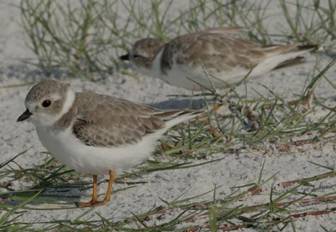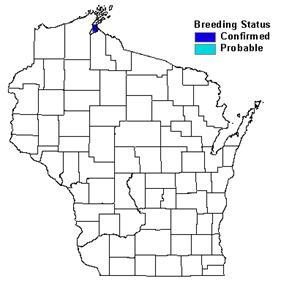Photo by Scott Franke


Status/Protection
- Global Rank: G3 Key to global and state ranks
- State Rank: S1
- WBCI Priority: SGCN, SBIRD, State Endangered
Population Information
- The International Piping Plover Breeding and Winter Census: 5,945 (Morrison et al. 2006)
- WSO Checklist Project: N/A
Life History
- Breeding Range: Northern Great Plains, beaches along the Atlantic Coast and northern Great Lakes (Haig and Elliot-Smith 2004).
- Breeding Habitat: Great Lakes Beach and Dune as well as alkali lakes, sandflats, and dredge islands (Haig and Elliot-Smith 2004).
- Nest: Scrape on sand, gravel or shell-covered substrates above high tide line (Haig and Elliot-Smith 2004).
- Nesting Dates: Eggs: June (Matteson 2006).
- Foraging: Ground glean, probes (Ehrlich et al. 1988).
- Migrant Status: Short-distance migrant, Neotropical migrant.
- Habitat use during Migration: Great Lakes Beach and Dune as well as alkali flats and shorelines of reservoirs and large lakes (Haig and Elliot-Smith 2004).
- Arrival Dates: Late April to early May (Robbins 1991).
- Departure Dates: Mid-July to late October (Robbins 1991).
- Winter Range: North Carolina to Florida and along the Gulf Coast from Florida to Texas, Mexico, and the Caribbean islands (USFWS 2003)
- Winter Habitat: Coastal beaches, sand flats, mudflats, and barrier islands (Haig and Elliot-Smith 2004).
Habitat Selection
Throughout its range, the Piping Plover selects open, sparsely vegetated sandy habitats for nesting, rearing young, and foraging. Foraging habitat varies depending on the availability of invertebrate prey, but generally includes wet sand in the wash zone, wrack lines, mud, sand and algal flats, and shorelines of streams, ephemeral ponds, and lagoons. Nest sites along Lake Michigan occur on sand spits or sand beaches sparsely vegetated with marram grass, bearberry, sand cherry, and willow; however, there is generally no vegetation within 5 m of the nest (Matteson et al. 2007). Beach width may be an important factor in nest site selection. Several studies in Michigan report mean beach widths >30 m and recent successful nesting attempts along Wisconsin’s Lake Superior shoreline (Long Island-Chequamegon Bay, Ashland Co.) also occurred on a stretch of beach >30 m wide (USFWS 2003, Matteson et al. 2007). The Recovery Plan for the Great Lakes Piping Plover (2003) suggests 7 m as the minimum width suitable for nesting Piping Plover.
Habitat Availability
Wisconsin supports Piping Plovers from the federally endangered Great Lakes population, which is isolated from the Atlantic and Northern Great Plains breeding populations. Habitat destruction and development have reduced the amount of nesting habitat available for the Piping Plover in Wisconsin and the Great Lakes region. For example, marina construction, residential development, and erosion control measures impede the natural processes needed to replenish sandy beaches. Recreational use of beaches, including both motorized and foot traffic, can also significantly reduce the value of otherwise suitable breeding sites and discourage re-colonization by breeding Piping Plover (USFWS 2003, WDNR 2005). In Wisconsin, human disturbance has compromised many of the beaches historically used by nesting Piping Plovers, including Sheboygan, Kenosha, Oconto, and Sturgeon bays along the Lake Michigan shoreline. Piping Plovers have not successfully nested at these locations since the 1940s (Robbins 1991) and today nest only at Long Island-Chequamegon Bay (Ashland Co.) and Outer Island in the Apostle Islands National Lakeshore where human disturbance is minimal. Although appropriate habitat conditions exist elsewhere, e.g., Point Beach State Forest and Whitefish Dunes State Park, high levels of human disturbance may prevent nesting (Matteson and Strand 1988, USFWS 2003).
Population Concerns
Results from three International Piping Plover Breeding Censuses indicate an increase in the global breeding population over the past ten years, including a substantial increase in the Great Lakes region. Since the 1991 census, the Great Lakes population has doubled in size and now includes 110 individuals (Morrison et al. 2006). Despite this population increase, the Great Lakes population remains critically endangered and is the most imperiled of the three sub-populations. In Wisconsin, only 12 nest have successfully fledged young since 1982, all occurring either on Outer Island or Long Island-Chequamegon Bay from 1998-2007 (Matteson et al. 2007, R. Brady, pers. comm.). USFWS (2003) lists a Great Lakes recovery goal as 300 individuals maintained for 5 years, with at least 100 breeding pairs in Michigan and 50 breeding pairs elsewhere in the Great Lakes region. Recent population viability models suggest that a substantial increase in reproductive success must occur in order to meet this target population size (USFWS 2003, Haig and Elliot-Smith 2004).
The restricted breeding range and small population size of the Great Lakes population makes it extremely vulnerable to chance demographic and environmental events, which could extirpate this species from our region. Furthermore, the small, geographically isolated nature of the Great Lakes breeding population potentially limits inter-regional gene flow and may reduce the overall fitness of the population. Habitat loss, recreational pressure, predation, and contaminants also are significant threats to maintaining a Great Lakes population of Piping Plover (USFWS 2003).
Recommended Management
Shoreline protection along the Great Lakes is critical for Piping Plover recovery and will require coordination with local planning and zoning boards. Although essential breeding sites receive limited regulatory protection through federal critical habitat designation, additional land acquisition and conservation easements are needed (USFWS 2003). At known breeding sites, conservation strategies include limiting human activity at nest sites, constructing predator exclosures around nests, controlling avian and mammalian predators, and protecting natural processes that maintain dune ecosystems and essential breeding habitat (USFWS 2003, Haig and Elliot-Smith 2004). Educational programs designed to engage local communities in Piping Plover conservation also are critical to this species’ recovery.
Research Needs
More research is needed to identify factors limiting Piping Plovers at current and historic nest sites. In particular, studies investigating the impacts of registered pesticide use on breeding Piping Plovers are warranted. More information is needed regarding the genetic variation within the Great Lakes population and among the three breeding populations. Annual surveys of all known current, historic, and potential breeding sites should be surveyed annually to determine management needs and further identify important conservation areas. Banding efforts on the breeding grounds should be continued in order to expand our knowledge on adult and juvenile survivorship, recruitment, and dispersal. Banding efforts, in concert with intensive winter surveys, will help identify key winter sites for the Great Lakes population (USFWS 2003). For example, one Wisconsin individual banded in the summer of 2006 was observed in southwestern Florida that winter (S. Matteson, pers. comm.).
Information Sources
- Audubon WatchList species account: http://audubon2.org/webapp/watchlist/viewSpecies.jsp?id=160
- Cornell Lab of Ornithology species account: http://www.birds.cornell.edu/AllAboutBirds/BirdGuide/Piping_Plover.html
- Great Lakes Piping Plover recovery plan: http://www.fws.gov/midwest/endangered/pipingplover/recplan-fnl.html
- Upper Mississippi Valley/Great Lakes Regional Shorebird Conservation Plan: http://www.fws.gov/shorebirdplan/RegionalShorebird/downloads/UMVGL5.doc
- U.S. Fish and Wildlife Service Piping Plover fact sheet: http://www.fws.gov/midwest/endangered/pipingplover/chabitat.html
- U.S. Geological Survey species account: http://www.mbr-pwrc.usgs.gov/Infocenter/i2770id.html
- U.S. Shorebird Conservation Plan: http://www.fws.gov/shorebirdplan/USShorebird/downloads/USShorebirdPlan2Ed.pdf
References
- Ehrlich, P.R., D.S. Dobkin, and D. Wheye. 1988. The birders handbook: a field guide to the natural history of North American birds. Simon & Schuster, Inc. New York.
- Haig, S.M. and E. Elliott-Smith. 2004. Piping Plover Charadrius melodus. In The Birds of North America Online. (A. Poole, Ed.) Ithaca: Cornell Laboratory of Ornithology; retrieved from The Birds of North American Online database (1 June 2007).
- Matteson, S.W. and F.C. Strand. 1988. Management and reintroduction of the Piping Plover in Wisconsin – 1987. Bureau of Endangered Resources, Wisconsin Endangered Resources Report 44. Wisconsin Department of Natural Resources, Madison. 10 pp.
- Matteson, S.W. 2006. Piping Plover. In Atlas of the Breeding Birds of Wisconsin. (N.J. Cutright, B.R. Harriman, and R.W. Howe, eds.). The Wisconsin Society for Ornithology, Inc. 602pp.
- Matteson, S.W., J. Van Stappen, P. Burkman, and T. Doolittle. 2007. Piping Plovers breeding in Wisconsin, 1891-2006. Passenger Pigeon 69(1): 47-80.
- Morrison, R.I.G, McCaffery, B.J., Gill, R.E., Skagen, S.K., Jones, S.L., Page, G.W., Gratto-Trevor, C.L. & Andres, B.A. 2006. Population estimates of North American shorebirds, 2006. Wader Study Group Bull. 111: 67–85.
- Robbins, S. D. 1991. Wisconsin birdlife: population & distribution, past & present. Univ. of Wisconsin Press, Madison, WI.
- U.S. Fish and Wildlife Service (USFWS). 2003. Recovery Plan for the Great Lakes Piping Plover (Charadrius melodus). Ft. Snelling, Minnesota. 141pp.
- Wisconsin Department of Natural Resources (WDNR). 2005. Wisconsin’s Strategy for Wildlife Species of Greatest Conservation Need. Madison, WI.
Contact Information
- Compiler: William P. Mueller, iltlawas@earthlink.net
- Editor: Kim Kreitinger, K.Kreitinger@gmail.com
